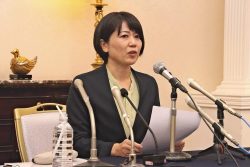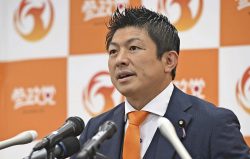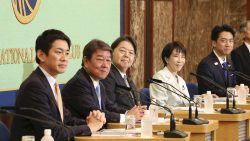Osaka-based Ishin gives anti-LDP conservative voters an outlet in Japan’s lower house election

Nippon Ishin no Kai vice representative Hirofumi Yoshimura gives a speech during the House of Representatives election to a large audience on Oct. 30 in Nishinomiya, Hyogo Prefecture.
November 5, 2021
Nippon Ishin no Kai (Japan Innovation Party) took 41 seats in the House of Representatives election, boosting it to the body’s third-largest party after the Liberal Democratic Party and the Constitutional Democratic Party of Japan.
The party had fallen to 11 seats in the last election in 2017, with many writing it off as a merely local political party for Osaka.
This time, all 15 candidates who ran in single-seat constituencies in Osaka won, and the party also gained a seat in Hyogo Prefecture.
Moreover, it also gained 15 proportional representation seats outside the Kinki bloc, which includes Osaka Prefecture. What is the secret behind Ishin’s success?
160 TV appearances
On Oct. 30, the final night of the campaign, about 2,000 people gathered in front of a department store in the Minami district of Osaka.
“I want to give the LDP a good scare,” shouted Ishin vice representative Hirofumi Yoshimura, surrounded by the noisy crowd, which gave him enthusiastic applause and cheers.
Yoshimura was the face of the party along with Ishin representative and Osaka Mayor Ichiro Matsui during the campaign.
When the novel coronavirus began spreading in the spring of last year, Yoshimura as governor of Osaka Prefecture started rolling out policies such as independent standards for easing business restrictions and opening facilities exclusively for critically ill patients.
He began appearing frequently on TV, logging at least 160 appearances since March last year. His words and deeds have been covered closely on the news.
With his frequent appearances on national broadcasts, a source connected to Ishin said, “His name recognition has really risen over the year and a half of the pandemic.”
Ishin made the most of Yoshimura’s popularity in the lower house election.
Hundreds of people gathered on a rainy afternoon in the Yurakucho district of Tokyo on Oct. 17, just before the election was officially announced.
“The word reform has disappeared from the LDP. How can we grow?” Yoshimura said as many in the audience snapped pictures with their phones. He seemed just as popular as in Osaka.
Ishin won two proportional representation seats in the Tokyo bloc. A source connected to the party in Tokyo said: “In the Kanto region, people had seen Ishin as a local political party. The presence of Mr. Yoshimura, who has become a national figure, was huge.”
Yoshimura put his focus on Tokyo, with its massive voting population, and Hyogo Prefecture, where the party has been gaining steam.
His crowds numbered in the hundreds everywhere he went. Amid this popularity, LDP candidates in Osaka desperately took to the streets to make their case.
“The House of Representatives election is not a vote of confidence on Gov. Yoshimura,” one candidate said.
Playing Ishin’s greatest
“Reform” was a keyword Ishin pushed relentlessly during the campaign.
Meanwhile, the LDP focused on “growth and distribution” and the CDPJ on “no growth without distribution.”
Ishin latched onto the absence of the word “reform” in Prime Minister Fumio Kishida’s keynote policy speech.
This confrontational stance was a change from the cooperative relationship between Matsui and former Prime Minister Yoshihide Suga. The day after Kishida’s speech, Yoshimura was upping his criticism of the LDP on the streets.
It has become Ishin’s characteristic strategy to to call for reforms by trumpeting its achievements in Osaka. These include reducing compensation for local government leaders, reducing the number of assembly members and using the funds generated by administrative and financial reforms to make private high school tuition and school lunch free.
“We lost the lower house elections in 2017 and 2014 because we couldn’t differentiate ourselves from [former Prime Minister Shinzo] Abe’s reform path. This time, the LDP stopped talking about reform and Ishin was able to grab the spotlight,” Matsui said.
In exit polls by The Yomiuri Shimbun and NTV-affiliated stations, 19% of unaffiliated voters chose Ishin for the proportional representation vote, up from 9% in the previous election in 2017.
“I think conservatives who were critical of the administration and didn’t expect reform from the LDP thought they could put their hopes in Ishin — and so did [left-leaning] voters who didn’t want to leave things to the CDPJ after it chose to fight alongside the Japanese Communist Party,” a senior Ishin official said.
Track record in Osaka
Nippon Ishin no Kai was formed in 2012 out of the local political party Osaka Ishin no Kai. Due to the outsize presence of its founder, former Osaka Mayor Toru Hashimoto, it was sometimes ridiculed as a “one-man shop.”
About a decade has passed since then. Party members now include the governor and mayor of Osaka. In 2017 it had about 180 lawmakers in the prefecture, a figure that has since grown.
Today, it is more than 250 strong, including 17 local government heads, and has built up a track record locally.
In Hyogo Prefecture, where it won one single-seat constituency and eight proportional representation seats in the latest election, a governor endorsed by Ishin was elected in July. It has also steadily gained local assembly members.
At a press conference on the evening of Oct. 31, Yoshimura said: “Local lawmakers and government heads will reform the administration. This is a way we can really compete with the LDP that I think is essential.”
Ishin made a spectacular debut in the 2012 lower house election when there was a big boom in “third pole” parties outside the major parties.
It has since undergone several setbacks, such as Hashimoto’s retirement from politics and losing referendums to create an “Osaka metropolis.”
But the party has persevered.
Matsui said: “We had Shintaro Ishihara [in our party] in 2012 and Kenji Eda in 2014. This time we went without any [such heavyweight] Kanto politicians and increased our seats nationwide, mostly through our Osaka members. That has major significance.”
Big rise in proportional votes
Proportional representation votes show how Ishin is going national.
In this election, aside from the 15 single-seat constituencies the party won in Osaka, it took only one seat in Hyogo. In proportional representation, on the other hand, it won a total of 25 seats. It won at least one seat each in 10 of the nation’s 11 proportional representation blocs, with the Hokkaido bloc as the sole exception.
This was more than triple the number in the previous election in 2017, when Ishin won five seats in the Kinki bloc and one seat each in Southern Kanto, Tokai and Kyushu, for a total of eight.
It also won 2.4 times more proportional representation votes than in 2017, receiving 8.05 million, or 14% of the total for all parties.
Ishin won 4.8 million votes for its 94 candidates who stood in single-seat constituencies nationwide, which suggests that many voters chose the party for proportional representation even when it was not running a candidate in their constituency.
Ishin received 12.26 million proportional votes, or 20% of the total, in 2012 when the party entered national politics, but this dropped to 8.38 million votes (16%) in 2014 and 3.38 million (6%) in 2017.
The share of votes for Ishin from prefectures outside Osaka was 88% in 2012, but dropped to 72% in 2017.
Despite being widely seen as a local political party, which has hindered its spread outside Osaka, 79% of its votes came from outside Osaka in the latest election.
By bloc, Ishin got 10 seats in Kinki, the same as its previous record in 2012. Its proportional vote count in that bloc was 3.18 million, exceeding the 2.99 million votes it won in 2012.
Outside of Kinki, it did best in the Southern Kanto bloc, where it won three seats with 860,000 votes, 3.2 times more than the previous election.
In the Tokyo bloc, where it had received no seats in the last election, Ishin’s vote count grew 4.3 times larger, which gained it two seats.
"Politics" POPULAR ARTICLE
-

Japan to Support Central Asian Logistics Route That Bypasses Russia, Plan to Be Part of Upcoming Summit in Tokyo
-

Japan to Tighten Screening of Foreigners’ Residential Status by Providing Information of Nonpayment of Taxes
-

Chinese, Russian Bombers Flew Unusual Path by Heading Toward Tokyo; Move Likely Meant to Intimidate Japan
-

Japan Plans National Database to Track Foreign Ownership of Real Estate, Land as It Weighs New Rules
-

Up to 199,000 Deaths Estimated From Mega-Tsunami; Most Recent Occurrence Took Place in 17th Century
JN ACCESS RANKING
-

Tokyo Economic Security Forum to Hold Inaugural Meeting Amid Tense Global Environment
-

Keidanren Chairman Yoshinobu Tsutsui Visits Kashiwazaki-Kariwa Nuclear Power Plant; Inspects New Emergency Safety System
-

Imports of Rare Earths from China Facing Delays, May Be Caused by Deterioration of Japan-China Relations
-

University of Tokyo Professor Discusses Japanese Economic Security in Interview Ahead of Forum
-

Japan Pulls out of Vietnam Nuclear Project, Complicating Hanoi’s Power Plans



























